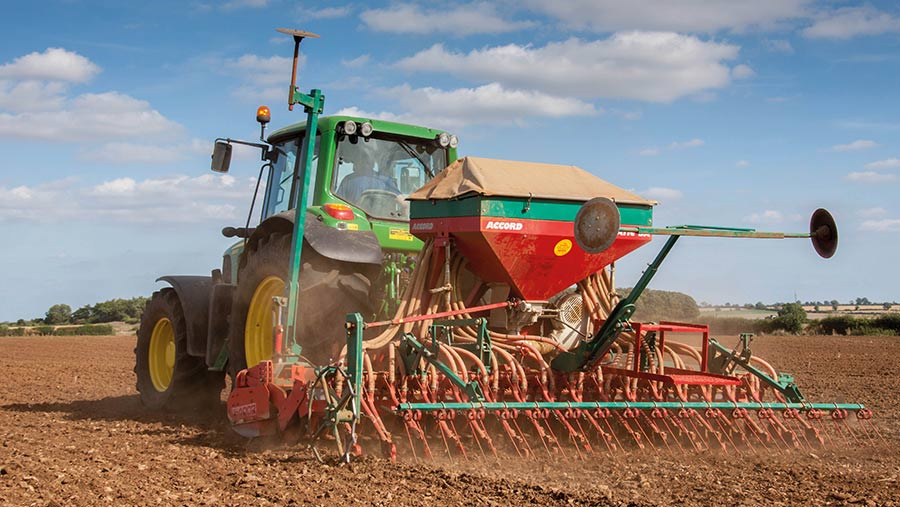Advice on when to drill next season’s oilseed rape crop
 © Tim Scrivener
© Tim Scrivener Oilseed rape growers are being urged to hold off drilling next season’s crops in this extremely dry summer until there is enough moisture in the soil.
Agronomy experts say even September-drilled crops in the Lincolnshire Wolds yielded over 6t/ha last season.
Bone-dry conditions across much of southern and eastern England have led to an early harvest with fields cleared ready for drilling oilseed rape.
However, growers need to be guided by soil moisture rather than calendar dates.
See also: Oilseed rape grower cuts back 20% on expensive nitrogen
With strong rapeseed prices at nearly £550/t for harvest 2023, many growers may be tempted back into the crop or look to increase their area.
But good establishment is key to preventing cabbage stem flea beetle (CSFB) pest problems and avoiding their main migration period, around the August bank holiday.
Rob Adamson, technical development manager at agronomy group ProCam, says growers should not rush into drilling crops too early as following a parched July this could be disastrous for crop establishment.
He adds that crops need to go into moist seed-beds and have more moisture forecast after germination:
“Growers are desperate to get oilseed rape crops in the ground, but it is so dry that often holding off could be the best policy. However, do not give up on the crop as what you do establish could be worth a lot come harvest.”
September drilling
If growers in dry southern and eastern England can hold off from drilling until about September 5-6 and crops emerge in mid-September they could escape the worst of the CSFB migration.
If drilled into warm moist soils the crops could still do well, according to Mr Adamson.
Growers further north will, hopefully, have seen more moisture and be able to drill earlier.
If drilling is delayed into early September to wait for sufficient soil moisture, he says this will increase the need for good seedling vigour.
In these situations hybrid varieties can prove their worth as hybrid vigour can help to mitigate the delayed start and grow away from any CSFB pressures.
As well as sowing hybrid varieties, using biostimulants to encourage rapid growth of a crop drilled later than usual into sufficient moisture can also aid successful establishment.
With both seed and foliar-applied biostimulants available, Mr Adamson says these treatments are a worthwhile investment.
“Maximising the growth rate is critical whether growing conventional or hybrid varieties. But the vigour of hybrid varieties can potentially be used as an extra method to maximise growth when time is of the essence,” he says.
High yields
Liam Wilkinson, arable development officer for plant breeder Limagrain, says holding back drilling need not necessarily compromise yield.
He says that later-drilled oilseed rape in good soil conditions can often outyield early-drilled crops put into the ground in poor conditions.
The breeder, which has a number of leading varieties such as Aurelia, Ambassador and Antigua, says that these vigorous hybrid types are often better suited to later drilling and a shortened time to establish in the autumn.
“Last year we saw crops of Antigua drilled mid-September up in the Lincolnshire Wolds achieve yields of over 6t/ha, so there is definitely high yield potential for crops drilled into September in the right conditions,” he says.
If growers are pushed back into drilling in September, he suggests the focus should be on speed of autumn growth and vigour.
In these circumstances, hybrids should be the first choice because they are quick to get going and accumulate biomass very quickly.
He points out that his group’s tried and tested varieties, such as Aurelia and Ambassador, have performed consistently well in late drilling slots.
The breeder’s newer varieties, such as Aviron, Auckland and Antigua, are also options for late drilling.
For these vigorous varieties, seed rates should be targeted to give 25-30 plants/sq m, which is normally around 50 seeds/sq m.
Mr Wilkinson recommends that growers assess seed-bed conditions and adjust seed rates accordingly to account for potential field losses.
Plant survival will obviously be higher when there is rain on or around the two weeks after drilling and this will allow the crop to germinate and grow away from CSFB attacks as quickly as possible.
Seed germination
Neil Watson, technical manager at agronomy group Hutchinsons, explains the importance of moisture at and after drilling.
He points out that oilseed rape seed goes through a two-stage process before emerging, with both stages requiring adequate moisture.
The first stage relies on the oilseed rape seed taking up 40% of its own weight in moisture before it can begin germinating.
It then goes into a second stage of repair and stabilisation, which requires more moisture to complete germination.
Mr Watson explains that seed often starts to germinate, but then withers away through lack of soil moisture, before completing emergence.
So sufficient moisture is needed in the soil to start the process and then more rain following drilling, to ensure the crop emerges.

